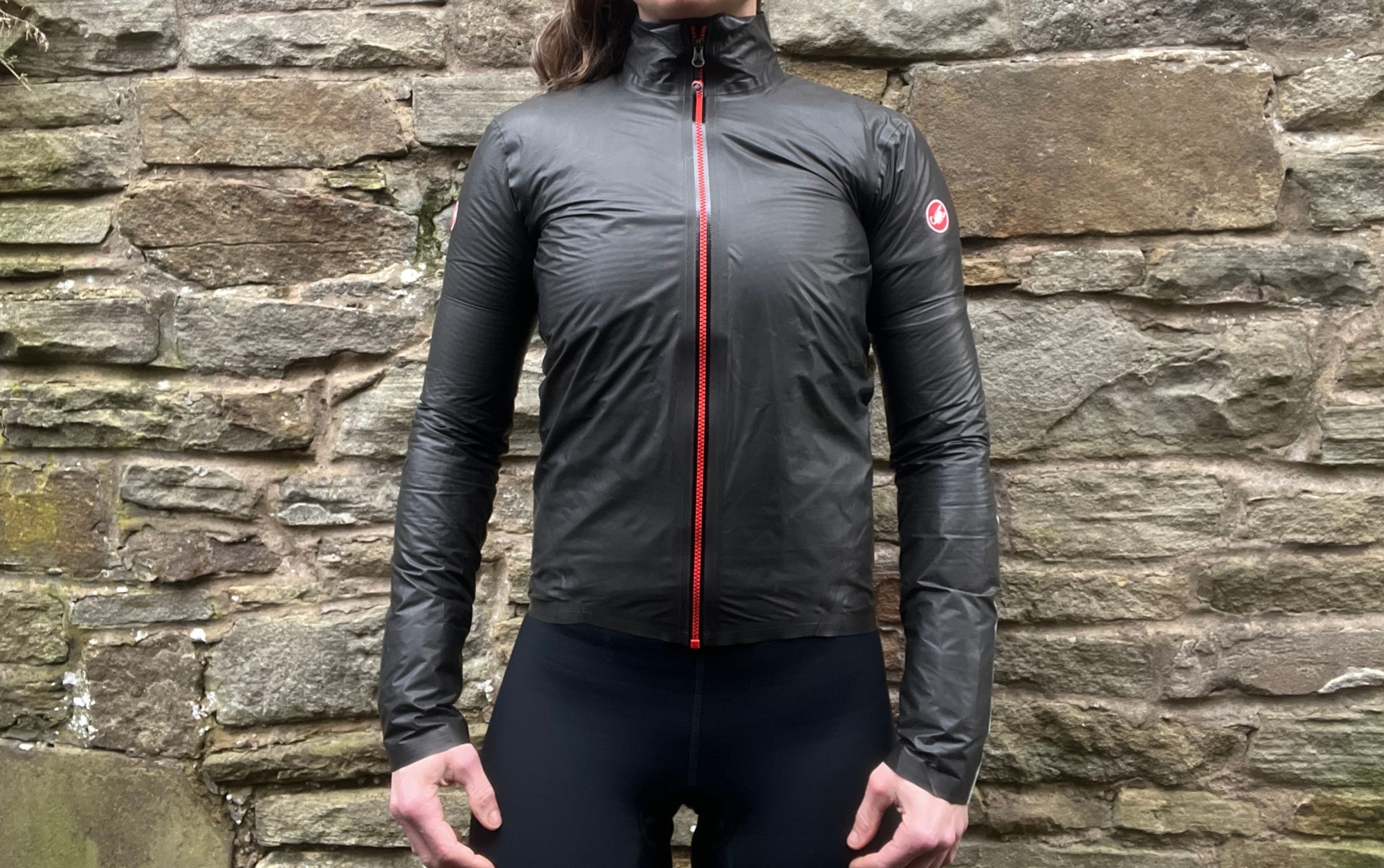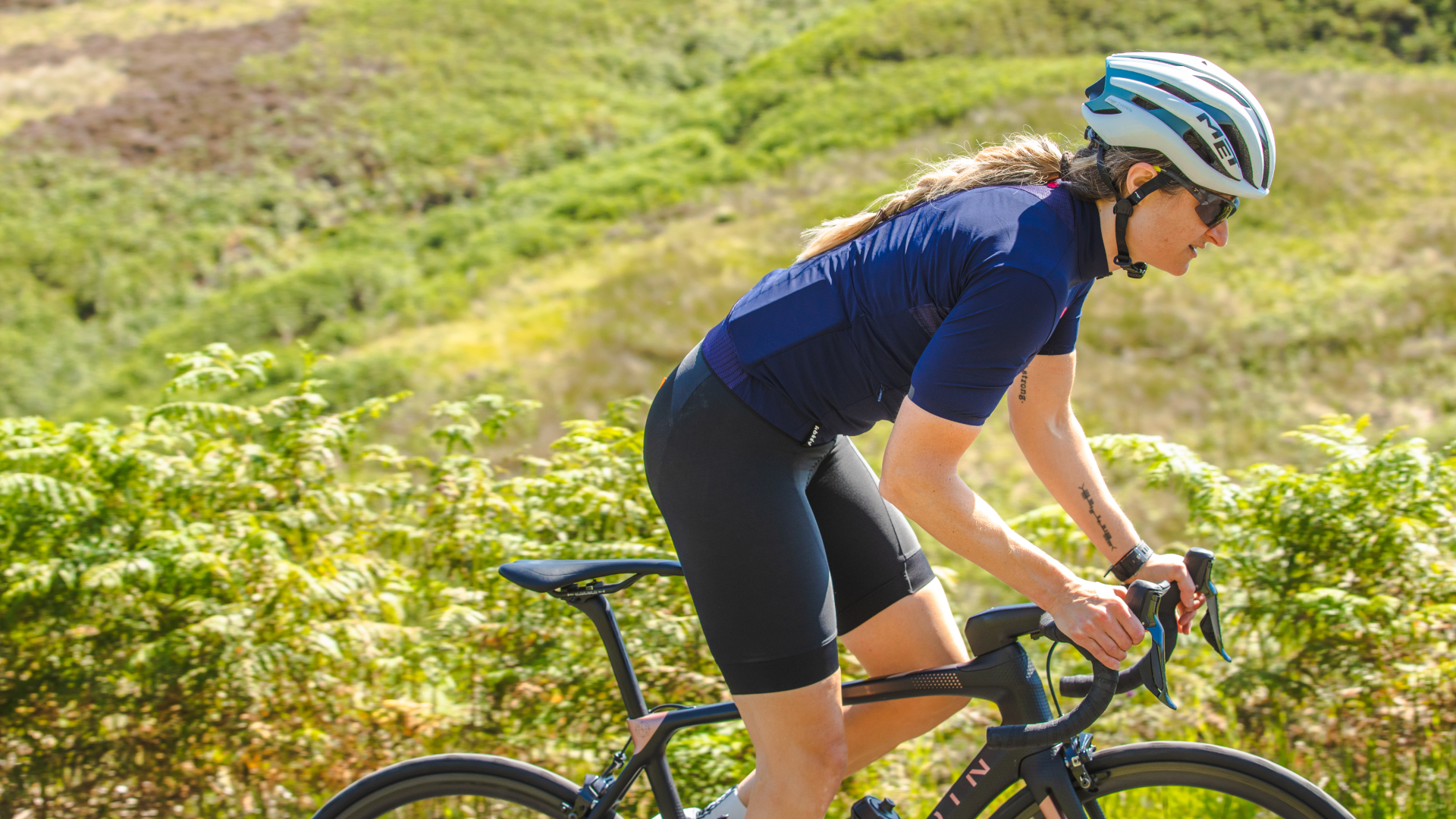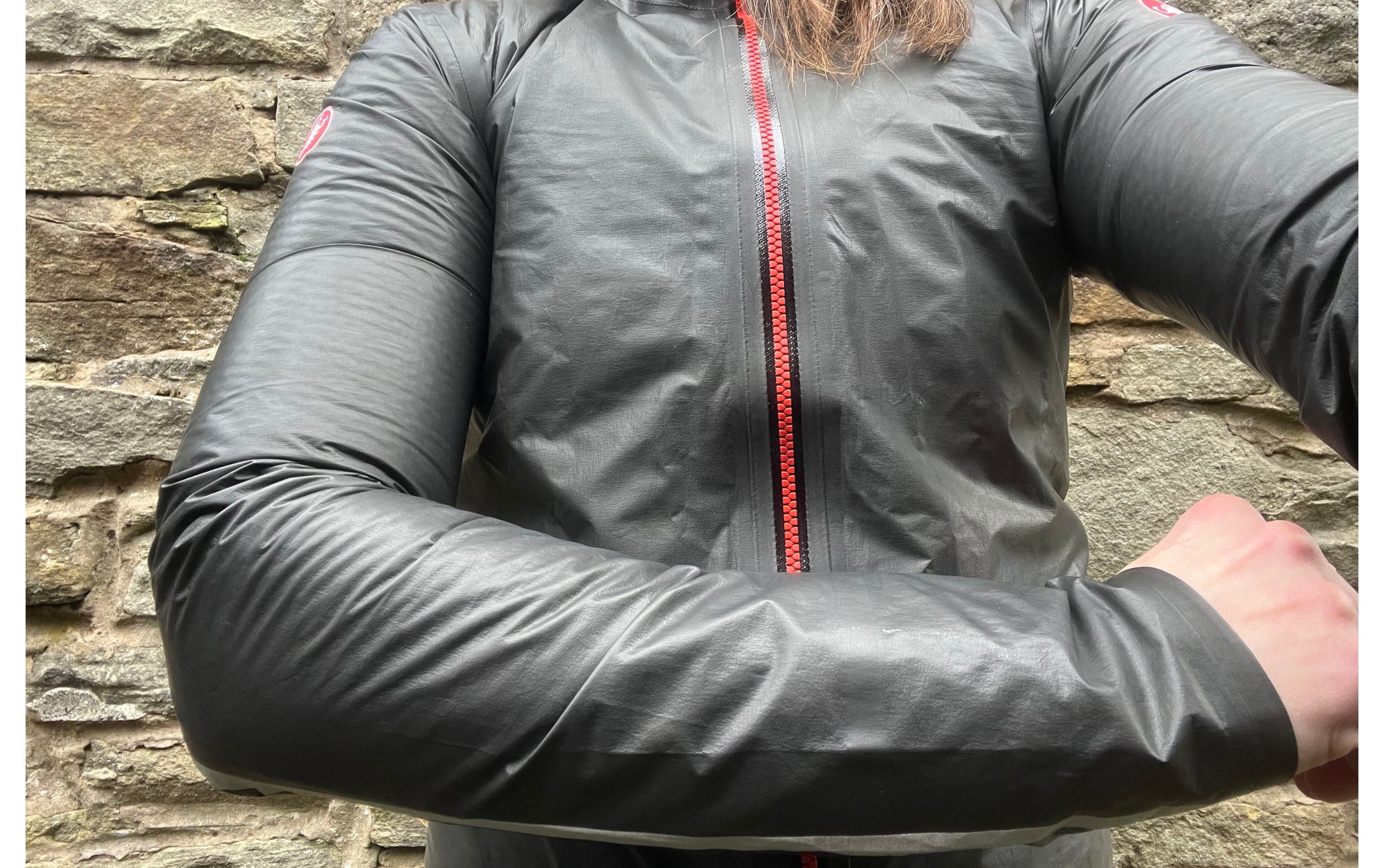Castelli Idro 3 W rain jacket review
Does the Italian brand drop another wet weather banger or clanger?

The Castelli Idro 3 W rain jacket provides impeccable performance against the elements, with almost impenetrable protection levels against rain and wind. Its breathability properties are undersold by the brand, as on test it manages heat build-up and dissipation well, even when riding hard with a thermal jacket underneath. Unfortunately the arm sizes on this women's-specific cut let the jacket down, with the tapering ratio from the top to bottom insufficient for a uniform fit. It's really frustrating to see on a brand we love so much and on a jacket that could be amazing, but when you're paying this much, you want pure perfection.
-
+
Wet weather and wind protection
-
+
Breathability even when climbing hard
-
+
Easily packs into a rear pocket
-
+
Exceptionally lightweight
-
-
Very tight fit on upper arms
-
-
The exceptionally high price tag
You can trust Cycling Weekly.

The last time we saw the Castelli Idro, it was the second version of the brand's top waterproof jacket and it had just been given full marks having been ridden circa 1,000 miles from tail to tip of Great Britain in the wettest week of 2020.
We're now on Castelli Idro 3 and, as any trilogy knows, the pressure is really on to ensure that it doesn't suffer from the third film curse and is more Toy Story and less Godfather.
While it's not quite 1,000 miles, riding the Castelli Idro 3 W rain jacket over the winter and early spring in the Peak District will truly test any brand's claims of full water and windproof capabilities.
Castelli Idro 3 W rain jacket: construction
The vast majority of the jacket is constructed using the Gore-Tex Shakedry material. And yes, it's the very same version as featured on the much respected Gore Shakedry jackets, and other versions of the Idro.
To the uninitiated, Shakedry is a two-layer fabric that puts the water barrier on the outside. This differs from more traditional Gore-Tex 3L (three layer) fabric that sandwiches the waterproofing in between an outer textile and lining.
With Shakedry, the water simply 'shakes' off the outer, without soaking an additional outer layer first.

The Idro 3 has a stretch back panel and reflective taping on the arms.
This laminated dual fabric also enables the Castelli Idro 3 W rain jacket to be exceptionally lightweight for a wind and waterproof piece of kit. The addition of the Gore-Tex Topo stretch panel on the lower back does add a few grams, with the small version that I tested tipping the scales at 115g compared to 109g for a size medium on the Castelli Idro 2. However, on the upside, the brand says that this will create a better fit for loaded rear pockets, or for anyone wanting a little more wriggle room round the middle without the bagging or flapping of a looser-cut design.
Elsewhere are taped seems, bonded raw-cut hems and cuffs, which also have an inner wrist gaiter for comfort, with a 7cm tall collar, reflective strips on the arms and across the lower back.
The ride
It's exceptionally hard not to sound like a total fangirl when reviewing pretty much anything Castelli, but they just keep hitting us with hit after hit.
Ride credits of a working parent aren't always easy to come by, and the Castelli Idro 3 massively helps with the ability of making all ride conditions bearable, allowing me to seize every opportunity to get out on the bike.
In the main, I've been layering it over the Castelli Alpha Ros jacket, finding the duo perfect for maintaining warmth and waterproofing.
To sum up the time I've spent in the Castelli Idro 3 W rain jacket it has either needed to provide total protection on the exposed moorland tops against driving wind and rain, or high breathability from more dynamic riding.
The jacket's performance against the former was superb, with Batfink shield of steel wings level of defence against the elements, which in the north west of the UK can be mostly in the form of horizontal rain. Admittedly I wasn't out for endless hours in poor weather: I'd say you would be good for a couple of hours, perhaps slightly less, without the inevitable water ingress.
That alone, and its ability to bundle down small enough to shove in a back pocket, is enough for most cyclists. But there is one more trick up the Castelli Idro 3 W's sleeve: its breathability.
Although Castelli doesn't highlight this as a feature, it's doing itself a disservice, as even when overlaid on the abovementioned thermal jacket, it balanced heat dissipation well. I certainly wasn't wringing sweat out my base layer at the end of some of the most challenging dynamic rides that I've tackled for a long time (read my review of the Stayer Groadinger UG if you really want to know exactly how dynamic).
But it's this requirement to deal with dynamism that actually found the Castelli Idro 3 W's Achilles heel. The brand is quick to shine a light on the new stretchy lower back of the jacket, which does make it easy to zip round full pockets, and stretch up to access them. What makes it almost impossible is the tightness of the arms, making bending them almost impossible.

The arms on the jacket are tight at the top until the mid- forearm, before becoming too lose.
Even with a lightweight thermal jersey on, I'm concerned my biceps are going to burst a seam, like an overcooked sausage. At the other end of the arm, however, it's the opposite, with slightly too much fabric around my forearm. To give some perspective, my bicep measures a modest 31cm/12.2in in diameter, while the middle of my forearm is just 24cm/9.3in in diameter. Hardly the Förstemann of arms.
Without dismantling the jacket to get exacting fabric measurements, a crude layout and doubling the calculation gives me a 28cm/11in bicep an a 24 cm/9.3in forearm. While the numbers might not be 100% accurate, the sizing taper seems to be out.
A quick google and well researched Criticalbody.com, which cites its references to published papers, found evidence based on available research data from the Centres for Disease Control and Prevention during 2015-2018 that the average women's bicep is around 32cm/12.5in, with my age group of 40-49 measuring 35cm/13.11in.
Forearm circumference data gleaned from the same site, based on available data, is between 23 and 24cm/9.3 and 9.5in (left arm/right arm).
Doing the math, this would suggest that there should be around a 28% difference between the width of the fabric at the top of the arm and middle of the bottom as apposed to the 15% taper that the Castelli Idro 3 W provides.
The arms are also a little (around 3cm/1in) too long, which makes them only team perfectly with either very thin gloves that you can just about squeeze under the cuff, or short wrist gloves that allow you to roll the sleeves up inside around the wrist. Well, put that down to just my biological shortcomings, over the longcomings of the jacket, which FYI measures 65cm/25.5in from shoulder to hem of cuff.
Value and conclusion
The price of the Castelli Idro 3 W rain jacket is the proverbial elephant and arguably also a kick in it too.
No matter what currency you part with, you're looking at the best half of a smart turbo trainer that could keep you out of the weather all together and snug at home. But as well researched and known, the benefits of riding a bike outside are tenfold, and Zwift also doesn't have a teleportal.
It's certainly a considerable amount of money to spend on one piece of kit, but if you can make the sizing work for you, then cancel your online riding subscriptions
immediatamente as there really won't be any excuses not to get out and ride.
For me, and the average female arm ratio owners, we're probably better off waiting for Castelli Idro 4 to land with hopefully more realistic arm sizing. Even if it were a hundred off the ticket price I could be tempted by the jacket performance to overlook the arm issue, but for the asking price, I think I'll pass.
| Fabric: | GORE-TEX® Shakedry, GORE-TEX® Stretch |
| Weight: | 115g (size small) |
| Sizes: | XS - XL |
| RRP: | £300/$299.99 |

Thank you for reading 20 articles this month* Join now for unlimited access
Enjoy your first month for just £1 / $1 / €1
*Read 5 free articles per month without a subscription

Join now for unlimited access
Try first month for just £1 / $1 / €1
Get The Leadout Newsletter
The latest race content, interviews, features, reviews and expert buying guides, direct to your inbox!
Hannah is Cycling Weekly’s longest-serving tech writer, having started with the magazine back in 2011. She has covered all things technical for both print and digital over multiple seasons representing CW at spring Classics, and Grand Tours and all races in between.
Hannah was a successful road and track racer herself, competing in UCI races all over Europe as well as in China, Pakistan and New Zealand.
For fun, she's ridden LEJOG unaided, a lap of Majorca in a day, won a 24-hour mountain bike race and tackled famous mountain passes in the French Alps, Pyrenees, Dolomites and Himalayas.
She lives just outside the Peak District National Park near Manchester UK with her partner, daughter and a small but beautifully formed bike collection.
-
 Man hands himself in to Belgian police after throwing full water bottle at Mathieu van der Poel during Paris-Roubaix
Man hands himself in to Belgian police after throwing full water bottle at Mathieu van der Poel during Paris-Roubaix30-year-old was on Templeuve-en-Pévèle cobbled sector when television pictures showed the bottle hitting him in the face
By Tom Thewlis Published
-
 'I'll take a top 10, that's alright in the end' - Fred Wright finishes best of British at Paris-Roubaix
'I'll take a top 10, that's alright in the end' - Fred Wright finishes best of British at Paris-RoubaixBahrain-Victorious rider came back from a mechanical on the Arenberg to place ninth
By Adam Becket Published
-
 'This is the furthest ride I've actually ever done' - Matthew Brennan lights up Paris-Roubaix at 19 years old
'This is the furthest ride I've actually ever done' - Matthew Brennan lights up Paris-Roubaix at 19 years oldThe day's youngest rider reflects on 'killer' Monument debut
By Tom Davidson Published